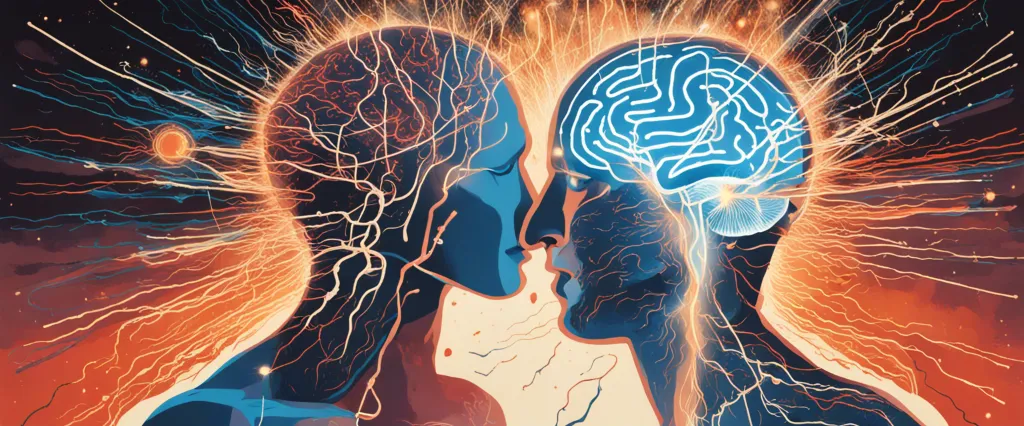In “Spark: The Revolutionary New Science of Exercise and the Brain,” John J. Ratey explores the transformative power of exercise on the human brain, revealing how physical activity not only enhances our overall health but also improves our cognitive abilities and mental well-being. As an internationally recognized psychiatrist and author, Dr. Ratey combines his expertise in neuroscience with compelling research to uncover the astonishing connection between exercise and the brain’s capacity for learning, attention, and emotional resilience. By unraveling this groundbreaking science, Ratey provides invaluable insights into how we can optimize our brain function and unlock our full potential through the simple act of moving our bodies.
Chapter 1: The Brain-Body Connection
Chapter 1 of the book “Spark” by John J. Ratey examines the intricate relationship between the brain and the body and how physical exercise positively impacts mental health and cognitive abilities. Ratey introduces the concept of neuroplasticity, which refers to the brain’s ability to change and adapt throughout a person’s life.
The chapter emphasizes how exercise is vital for overall brain health and function. It explores the idea that exercise is not solely for physical fitness but also crucial for mental well-being, reducing the risk of mental illnesses such as depression, anxiety, and attention deficit hyperactivity disorder (ADHD). Ratey cites various studies that support his claims, highlighting the positive effects of exercise on mental health.
Additionally, the chapter underscores the importance of physical activity in boosting cognitive abilities and academic performance. Ratey discusses how exercise increases the production of neurotrophic factors, which aid in the growth of new brain cells and the formation of neural connections. This, in turn, enhances learning, memory, and attention span.
Ratey examines the relationship between exercise and stress, proposing that physical activity acts as a stress-reliever by reducing the levels of stress hormones in the body. He also explores the impact of exercise on executive functioning, decision-making, and creativity, emphasizing that regular physical activity improves these cognitive functions.
Overall, Chapter 1 of “Spark” focuses on the brain-body connection and how exercise positively influences mental health, cognitive abilities, and overall well-being. Ratey emphasizes the importance of incorporating physical activity into daily routines as a means to optimize brain function and enhance mental health.
Chapter 2: The Evolution of Exercise
Chapter 2 of the book Spark by John J. Ratey delves into the evolution of exercise and highlights the biological connection between physical activity and the human brain. Ratey explores how our ancestors’ survival skills were rooted in enduring physical tasks, which, when accomplished, had a direct impact on their brains. Throughout history, movement has been fundamental to our species’ survival and has shaped our brains to function optimally in the presence of physical exercise.
Ratey discusses the concept of “dirty genes,” which refers to our genetic predisposition to be physically active. Our ancestors who were more physically active were more likely to survive and pass down these genes. In turn, our brain developed to be rewarded by exercise.
The chapter emphasizes the importance of movement for brain function. Exercise increases the production of brain-derived neurotrophic factor (BDNF), a protein that supports the growth and maintenance of neurons. BDNF plays a crucial role in neuroplasticity, the brain’s ability to change and adapt.
Ratey explores the impact of sedentary lifestyles on our brains. With the rise of technology and modern conveniences, physical activity has become less necessary for survival, leading to negative consequences for our brain health. Rates of mental disorders such as depression, anxiety, attention deficit hyperactivity disorder (ADHD), and Alzheimer’s disease have increased, which Ratey directly correlates with the decline in physical activity.
In conclusion, Chapter 2 of Spark emphasizes the deep-rooted connection between exercise and the human brain. The evolutionary history of physical activity provides evidence for the important role movement plays in brain development and function. By understanding this connection, we can harness the benefits of exercise to improve our mental well-being and combat the negative consequences of a sedentary lifestyle.
Chapter 3: The Learning Brain
Chapter 3 of “Spark” by John J. Ratey, titled “The Learning Brain,” delves into the relationship between physical activity and learning. Ratey explores the significant impact exercise has on the brain’s ability to absorb and retain information, while emphasizing the crucial role physical fitness plays in academic achievement.
The chapter begins by discussing the positive effects of exercise on the brain’s neuroplasticity, which is its ability to change and reorganize itself. Ratey explains that physical activity releases various chemicals in the brain, such as growth factors and neurotransmitters, which promote the growth of new neural connections. This, in turn, enhances learning and memory by optimizing the brain’s ability to process information effectively.
Ratey also highlights the importance of exercise in reducing stress and anxiety, factors that can impair learning and cognition. He explains the reciprocal relationship between physical fitness and mental health, emphasizing that exercise acts as a natural antidepressant, reducing symptoms of depression and anxiety and improving overall mood. As a result, students who engage in regular physical activity tend to exhibit better focus, increased attention span, and improved academic performance.
Furthermore, Ratey explores how exercise positively impacts executive functions, including attention, problem-solving, and decision-making. He describes how physical activity stimulates the brain’s prefrontal cortex, a region responsible for such cognitive functions, ultimately leading to improved cognitive flexibility, creativity, and self-control.
In summary, Chapter 3 of “Spark” highlights the compelling evidence behind the powerful connection between physical activity and learning. Regular exercise not only improves neuroplasticity, but also reduces stress and enhances executive functions, resulting in optimal conditions for academic achievement and overall cognitive functioning.
Chapter 4: The Anxious Brain

Chapter 4: The Anxious Brain of the book “Spark” by John J. Ratey delves into the topic of anxiety and how it affects the brain. Ratey emphasizes that anxiety is not just a psychological issue, but a physical one as well, presenting substantial evidence connecting anxiety to the brain’s biochemical processes.
The chapter highlights the amygdala, a small structure deep within the brain that plays a primary role in anxiety. The amygdala is responsible for processing emotions and activating the body’s fight-or-flight response. People with an overactive amygdala experience heightened anxiety, making them more susceptible to stress and less capable of managing it effectively.
Ratey explains that exercise plays a crucial role in reducing anxiety by calming the amygdala. Physical activity increases the release of mood-enhancing neurotransmitters like serotonin, dopamine, and norepinephrine, which help regulate emotions, improve focus, and reduce anxiety. He presents studies that demonstrate how regular exercise can be as effective as medication for treating anxiety disorders.
Furthermore, physical activity promotes neurogenesis, the growth of new brain cells, particularly in the hippocampus, a region associated with memory and emotion regulation. Through exercise, the hippocampus becomes more robust and resilient, mitigating anxiety and enhancing mental health.
The chapter also highlights the benefits of exercise for those with post-traumatic stress disorder (PTSD). Ratey shares stories of individuals who have found relief from their symptoms through physical activity, as it helps reduce the amygdala’s reactivity and enhances connectivity with the prefrontal cortex, responsible for rational thinking.
In summary, Chapter 4 illustrates the intricate relationship between anxiety and physical exercise. By engaging in regular physical activity, individuals can alleviate anxiety symptoms, regulate emotions effectively, and foster a healthier brain.
Chapter 5: The Depressed Brain
Chapter 5: The Depressed Brain of the book “Spark” by John J. Ratey explores the intricacies of depression and its impact on the brain. It delves into the various biological and neurological aspects that contribute to this debilitating mental health condition.
The chapter begins by emphasizing the prevalence of depression in society and its detrimental effects on individuals, their families, and society as a whole. It highlights the alarming rise in depression rates, particularly among teenagers and young adults.
Ratey presents the idea that depression is not solely a psychological disorder but also a consequence of dysfunctions within the brain. He examines the role of neurotransmitters like serotonin, norepinephrine, and dopamine, explaining how imbalances in these chemicals can contribute to the development of depression. Ratey also highlights the involvement of the amygdala, the prefrontal cortex, and the hippocampus, which are brain regions associated with emotional regulation, cognitive control, and memory formation, respectively.
Furthermore, the chapter explores the link between depression and neuroplasticity, the brain’s ability to change and adapt. Ratey explains that individuals with depression often experience reduced neuroplasticity, which further perpetuates the negative emotions and behaviors associated with the condition.
To tackle depression, Ratey presents exercise as a powerful tool. He explains how physical activity promotes the production of endorphins, serotonin, and other chemicals that help lift mood and alleviate depressive symptoms. Exercise also enhances neuroplasticity, which can aid in rewiring the brain in a more positive direction.
Overall, Chapter 5 of “Spark” sheds light on the biological underpinnings of depression, highlighting the importance of a holistic approach that encompasses both psychological and neurobiological interventions to effectively address this challenging condition.
Chapter 6: The Addicted Brain
Chapter 6 of “Spark” by John J. Ratey, titled “The Addicted Brain,” explores the effects of addiction on the brain and how exercise can play a vital role in breaking free from these destructive patterns.
The chapter begins by highlighting the devastating impact of addiction, emphasizing that it is not a character flaw or simply a lack of willpower but rather a complex brain disease. Ratey explains that addiction alters the brain’s chemical structure, affecting the reward system and diminishing the ability to experience pleasure from natural rewards. Consequently, addicts become trapped in a cycle of seeking the substance or behavior that triggers the release of dopamine, the brain’s pleasure chemical.
Ratey emphasizes that exercise can significantly contribute to overcoming addiction. He explains that physical activity stimulates the release of dopamine, providing a natural way of experiencing pleasure and satisfaction without relying on addictive substances or behaviors. Exercise also helps rebalance brain chemistry by influencing the production of endorphins, serotonin, and other neurotransmitters, reducing cravings and improving mood.
Moreover, exercise can aid in recovering addicts’ overall well-being. It reduces stress, anxiety, and depression by engaging the brain’s stress-response system and increasing the release of stress-reducing chemicals. Physical activity also fosters self-control and discipline, which are essential in overcoming addiction.
The chapter shares numerous success stories of individuals who have used exercise as a tool in their recovery. These stories demonstrate that exercise not only helps mitigate the physiological effects of addiction but also empowers individuals to regain control of their lives.
In summary, Chapter 6 of “Spark” asserts the neurobiological basis of addiction and the profound impact exercise can have as a powerful tool in the process of recovery. By understanding the brain’s response to addiction and utilizing exercise as a means of restoring balance and pleasure, individuals can break free from the grip of addiction and embark on a path of long-term recovery and improved well-being.
Chapter 7: The Resilient Brain
Chapter 7 of the book “Spark” by John J. Ratey is titled “The Resilient Brain.” This chapter focuses on the incredible ability of the brain to adapt and grow through exercise, and how exercise can improve cognitive function and mental health.
Ratey starts by explaining that exercise not only increases blood flow to the brain, which provides it with more oxygen and nutrients, but it also stimulates the release of various neurotransmitters, such as dopamine, serotonin, and norepinephrine. These neurotransmitters, often referred to as the “feel-good” chemicals, play a crucial role in regulating mood, reducing anxiety and depression, and improving focus and motivation.
The chapter discusses the impact of exercise on learning and memory. Exercise has been shown to enhance the growth of new neurons in the hippocampus, the brain region crucial for learning and memory formation. Moreover, exercise promotes the production of a protein called BDNF (brain-derived neurotrophic factor), which helps in the survival and growth of neurons and strengthens connections between brain cells, thus improving cognitive function.
Ratey also emphasizes the importance of exercise in combating stress. Regular physical activity has been found to reduce levels of stress hormones like cortisol and increases the production of endorphins, which has a calming effect on the brain. This can lead to increased resilience, improved emotional well-being, and better overall mental health.
In this chapter, Ratey also explores the impact of exercise on attention deficit hyperactivity disorder (ADHD), anxiety disorders, and age-related cognitive decline. He presents studies showing that exercise can alleviate symptoms of ADHD and anxiety by increasing focus, reducing impulsivity, and promoting relaxation. Additionally, exercise has been proven to combat age-related cognitive decline, decreasing the risk of developing conditions such as Alzheimer’s disease.
Overall, “The Resilient Brain” chapter emphasizes that exercise has profound effects on the brain’s structure and function. It highlights the importance of physical activity in promoting mental well-being, enhancing cognitive abilities, and improving overall brain health.

Chapter 8: The Aging Brain
Chapter 8 of the book “Spark” by John J. Ratey, titled “The Aging Brain,” explores the effects of exercise on the aging brain and highlights the importance of physical activity in maintaining cognitive health as we age.
The chapter begins by discussing the normal age-related changes that occur in the brain. The author explains that as we get older, the brain naturally undergoes a process of shrinkage and loses some of its mental faculties. However, studies have shown that regular exercise can slow down the aging process and even reverse some of these negative effects.
Ratey presents robust evidence demonstrating the positive impact of exercise on cognitive function in older adults. He refers to a study conducted by Arthur Kramer at the University of Illinois, which revealed that aerobic exercise increases the size of the hippocampus—a brain region critical for memory consolidation—and improves memory and attention span in older adults.
Furthermore, the chapter discusses the role of exercise in delaying or preventing cognitive decline and neurodegenerative diseases, such as Alzheimer’s and dementia. Physical activity increases blood flow to the brain, stimulates the release of growth factors that support the survival of existing neurons, and promotes the growth of new neurons and connections.
Ratey also emphasizes the importance of lifelong physical activity, stating that starting an exercise routine early in life significantly reduces the risk of cognitive decline in older age. Additionally, he explains that a combination of aerobic exercise, strength training, and coordination exercises yields the most substantial cognitive benefits.
In conclusion, Chapter 8 of “Spark” underscores how exercise has the power to positively impact the aging brain. Regular physical activity not only enhances cognitive function but also promotes brain health and resilience, decreasing the risk of age-related cognitive decline and neurodegenerative diseases.
After Reading
In conclusion, “Spark” by John J. Ratey presents a compelling argument for the vital role of exercise in enhancing brain function and overall well-being. Through extensive research and captivating anecdotes, Ratey demonstrates how physical activity is not only essential for our bodies but also for our minds. He highlights the transformative effects of exercise on mood regulation, cognition, learning, and even mental health conditions such as ADHD and depression. Additionally, the author emphasizes that exercise should be incorporated into our daily routines, especially in educational institutions, to optimize students’ academic performance and improve their overall mental health. Overall, “Spark” serves as a powerful reminder of the tremendous benefits that exercise has on our brains and lives.
1. The Brain that Changes Itself” by Norman Doidge: This book explores the concept of neuroplasticity and how our brains can adapt and rewire themselves. It delves into various case studies of individuals who have overcome different brain-related conditions. Recommended for readers interested in the brain’s remarkable potential for change and growth.
2. A Whole New Mind: Why Right-Brainers Will Rule the Future” by Daniel H. Pink: Examining the shift in the demands of the modern world, Pink explores the importance of creativity and right-brain thinking. This book offers valuable insights into how different ways of thinking can greatly impact our personal and professional lives.
3. The Power of Habit: Why We Do What We Do in Life and Business” by Charles Duhigg: Drawing on scientific research, Duhigg delves into the intricacies of our brain’s habit-forming processes and how we can reshape them. This highly engaging book offers practical strategies for changing and developing new habits.
4. Mindset: The New Psychology of Success” by Carol S. Dweck: Dweck explores the power of mindset and how our beliefs about intelligence and abilities significantly impact our achievements. Through case studies and research, she reveals the importance of cultivating a growth mindset for personal and professional growth.
5. “The Organized Mind: Thinking Straight in the Age of Information Overload” by Daniel J. Levitin: In today’s digital age, maintaining focus and managing information can be challenging. Levitin offers strategies and insights into how our brains perceive and organize information, providing practical solutions for maintaining mental clarity and productivity.
These book recommendations explore various aspects of the brain’s capacities, the power of mindset, personal growth, habit formation, and managing information overload.



